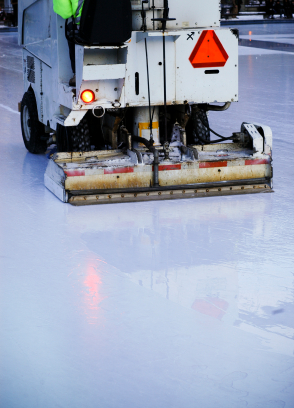 Attention hockey moms and dads: the air you and your children breathe at the rink may be hazardous to your health.
Attention hockey moms and dads: the air you and your children breathe at the rink may be hazardous to your health.
The culprit: gas-, diesel- and propane-powered ice resurfacing machines which spew out a toxic stew of carbon monoxide, nitrogen dioxide, and particulate matter, all which can result in potentially serious short- and long-term health problems.
Health dangers
Numerous studies have established a link between long-term exposure to high levels of carbon monoxide and ultrafine and fine particulate matter generated at indoor rinks by gas-, diesel- and propane-powered ice resurfacing machines and a high prevalence of respiratory problems such as asthma, exercise-induced bronchiospasm (EIB), peripheral airway inflammation and/or airway wall fibrosis among figure skaters, short-track speed skaters, and ice hockey players.1 A 2004 study found levels of ultrafine and fine particulate matter from hourly ice resurfacing by so-called "Zambonis" and ice edgers at levels twenty times outside air levels.
The short- and long-term effects of such pollutants are well-documented:
- Carbon monoxide:
- Low levels of carbon monoxide can cause shortness of breath, mild nausea, and mild headaches.
- At moderate levels, CO poisoning can cause severe headaches, dizziness, mental confusion, nausea, or fainting.
- At high levels, CO can cause loss of consciousness or death. Children, the elderly, and people with heart disease can be especially susceptible.
- Nitrogen dioxide:
- Low level: increased bronchial reactivity in some asthmatics, increased risk of respiratory infections, especially in young children.
- Continued exposure to high NO2 levels can contribute to development of acute or chronic bronchitis.
- Particulate matter can affect the heart and lungs and cause serious health effects.
In the news
Several recent incidents of carbon monoxide poisoning at rinks - one in Colorado in which 61 people, including spectators, were sickened, another in suburban Chicago in which 13 players, manager and coach of a Colorado midget-level hockey team were briefly hospitalized after complaining of headache, dizziness and vomiting, and, most recently, in Wisconsin, in which 25 players and coaches became ill - have highlighted the hidden dangers from air pollution at indoor rinks.
Indeed, a 2011 Today Show investigation found carbon monoxide and particulate levels at one neighborhood rink in Pennsylvania well above safe levels for children, and, even an hour after ice resurfacing, the levels were so dangerously high that the tester recommended that the Today crew leave the building. According to Today investigator, Jeff Rossen, news reports show that over 250 people have been poisoned at indoor rinks in just the past two years.
Little regulation
Yet, despite the well-recognized dangers, only three states (Minnesota, Massachusetts and Rhode Island) regulate ice rink air quality. The EPA has standards for emissions from ice resurfacers designed to reduce hydrocarbon emissions by about 71 percent, nitrous oxide emissions by about 80 percent, and carbon monoxide emissions by about 57 percent, but does not set air quality standards for indoor rinks.
Safety recommendations
Parents concerned about exposure to dangerous levels of CO, NO2, and particulate air pollution should:
- Ask the rink owner what kind of ice resurfacer is being used. Ask the owner to switch to an electric-powered ice resurfacing machine if a gas-, diesel- or propane-powered resurfacer is being used. The electric-powered models are twice as expensive but do not emit any dangerous pollutants.
- Ask whether carbon monoxide detectors have been installed, and, if not, demand that they be installed immediately;
- Be on the lookout for symptoms of carbon monoxide poisoning in your child, such as headache, dizziness, sluggishness, and vomiting.
- If you suspect carbon monoxide poisoning,
- get fresh air immediately by leaving the building
- go to an emergency room and be prepared to tell the physician you suspect carbon monoxide poisoning, which can be diagnosed by a blood test done soon after the exposure.
For additional action steps that should be taken by ice rink owners and managers recommended by the EPA, click here.
1. Rundell K, Spiering B, Evans T, Baumann J. Baseline Lung Function, Exercise-Induced Bronchoconstriction, and Asthma-Like Symptoms in Elite Women Ice Hockey Players. Med. Sci. Sports & Exerc. 2004;36(3):405-410.
Posted February 12, 2011, most recently revised and updated November 23, 2015








